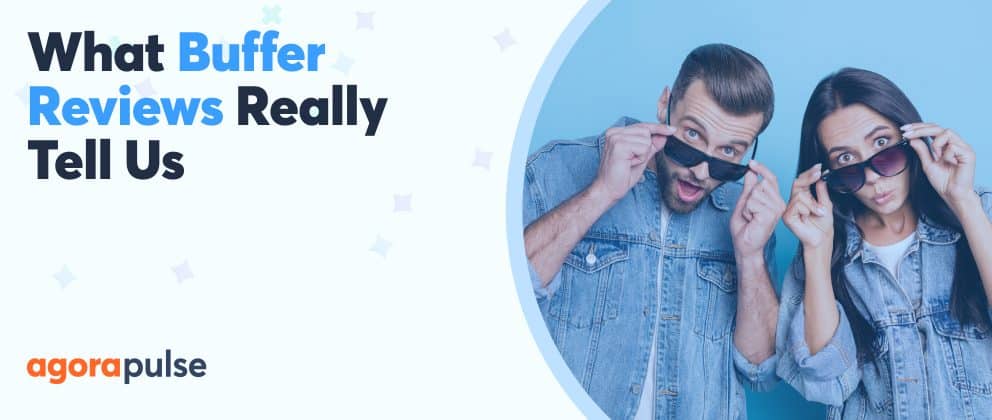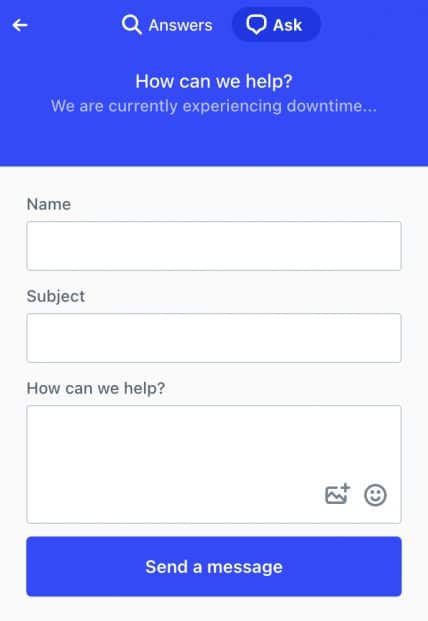With over 150,000 monthly active users, Buffer is one of the most popular social media tools on the market. But is it really the best option for social media managers? And more importantly, is it a smart investment for your team? Let’s dig into the Buffer reviews from actual users and find out.
To help you make the right decision, we analyzed Buffer reviews across three major software review sites: over 1,900 reviews on G2, over 2,100 reviews on Capterra, and over 900 reviews on TrustRadius. Even though this article is on the Agorapulse blog, we wanted to focus on cold, hard data.
Below, we’ll compare Buffer vs. Agorapulse side by side so you can choose the right tool for your team. And if you’d like to start comparing on your own, grab your free trial of Agorapulse and start testing it out right away.
Summary of Buffer Reviews
Here’s a high-level summary of this Buffer reviews analysis:
- Buffer’s product direction isn’t overwhelmingly positive. Buffer has experienced several years of slow growth and degraded service quality, leading to dissatisfaction in the product’s direction.
- Agorapulse is far ahead of Buffer in terms of support quality. Both platforms offer 24/7 support, but Buffer ranks far behind Agorapulse—which offers more support channels and guaranteed response times.
- Buffer lacks several important social media features. The platform’s feature set focuses heavily on content creation and publishing. It lacks the engagement, listening, and reporting features Agorapulse offers.
- Buffer’s lower base price can be misleading. Because Buffer has a limited feature set and charges per profile, its base price can be cheaper. But it won’t save you money if you need other tools to fill out your tech stack.
- Agencies are better off with Agorapulse. Buffer’s core customer base is small businesses and entrepreneurs. Agorapulse is ideal for agencies and offers a long list of agency-specific features.
1. Buffer Reviews: Its product direction isn’t exactly positive
Buffer was founded in 2010, making it one of the first social media management tools to launch in this software category. Although it achieved success and growth early on, Buffer hasn’t kept up this momentum in the intervening years.
In his 2023 letter to shareholders, Buffer’s CEO and founder states that the platform had “become fairly slow-moving” over the years. He also reflects on failed attempts to “find new growth” and laments that the product and service quality “gradually degraded.”
Positive product direction
While the team behind Buffer may intend to improve the product going forward, customer experiences don’t reflect these intentions. Instead, Buffer’s product direction (8.1) is a full point behind Agorapulse’s (9.1), according to G2 reviewers.

G2 product direction comparison: Agorapulse vs Buffer
Part of customers’ dissatisfaction with Buffer’s product direction may result from the platform removing features without providing a viable alternative. For example, Buffer sunset Reply, its social inbox tool, in 2020. Four years later, the platform still lacks a fully featured solution for managing social media engagement.
How much does product direction matter for social media managers? It depends on how much you value your investment.
Think about it this way. If you purchase a social media tool that doesn’t truly meet your needs (or that only does so for a short time), you’ll run into trouble quickly.
The sunk cost is only part of the problem. If that tool doesn’t grow with your team, you’ll waste a ton of time managing processes manually instead of automating them. You may also waste money on extra stopgap solutions.
Business partner potential
Whether you manage social media for a growing agency, a large organization, or a small company, purchasing software is about more than just the product. Part of the transaction is finding a partner that’s invested in your business.
G2 reviewers’ answer to the question, “Has the product been a good partner in doing business?” says a lot about how well the platform works with a typical team.
Agorapulse scores a 9.1, while Buffer gets an 8.8.

G2’s Business Partner Comparison of Agorapulse and Buffer
Likelihood to recommend or renew
Social media managers’ renewal plans can also tell you a lot about how much they really appreciate the platform. Nearly 100% of TrustRadius reviewers would purchase Agorapulse again. In contrast, only 90% would rebuy Buffer.

TrustRadius comparison of Agorapulse vs Buffer
TrustRadius reviewers are more likely to renew their Agorapulse contracts (9.1 compared to Buffer’s 8.0). They’re also more likely to recommend Agorapulse to colleagues (9.8 compared to Buffer’s 8.2).

TrustRadius comparison of Agorapulse vs Buffer reviews for recommendations
2. Buffer Reviews: Its support quality gets low ratings across review sites
Any social media marketing platform you choose should offer an excellent user experience. Yet it should also have reliable support in case you have questions or run into issues.
Both Agorapulse and Buffer users give their setup and configuration experiences relatively high ratings. But the two platforms have vastly different ratings for support quality.
Ease of setup and admin
In the eyes of G2 reviewers, Agorapulse and Buffer are neck and neck in terms of setup and admin. Both social media platforms have a 9.1 for ease of admin, which means users find them easy to manage for their teams.
Buffer (9.2) barely edges out Agorapulse (9.1) for ease of setup. These ratings suggest that on either platform, users find it remarkably easy to connect social media accounts and organize dashboards.

G2 ease of setup and admin comparison Agorapulse vs. Buffer
Agorapulse (8.9) just outranks Buffer (8.8) for users and permissions. Along the same lines, these ratings suggest that social media managers find it easy to onboard team members and configure user permissions.

G2 users and permissions comparison Agorapulse vs. Buffer
Overall, Capterra reviewers rate Agorapulse the highest of the two. But in terms of ease of use, Agorapulse and Buffer are tied with a 4.5 rating. These ratings suggest that even after the initial setup process, social media managers find the two platforms relatively intuitive to navigate.
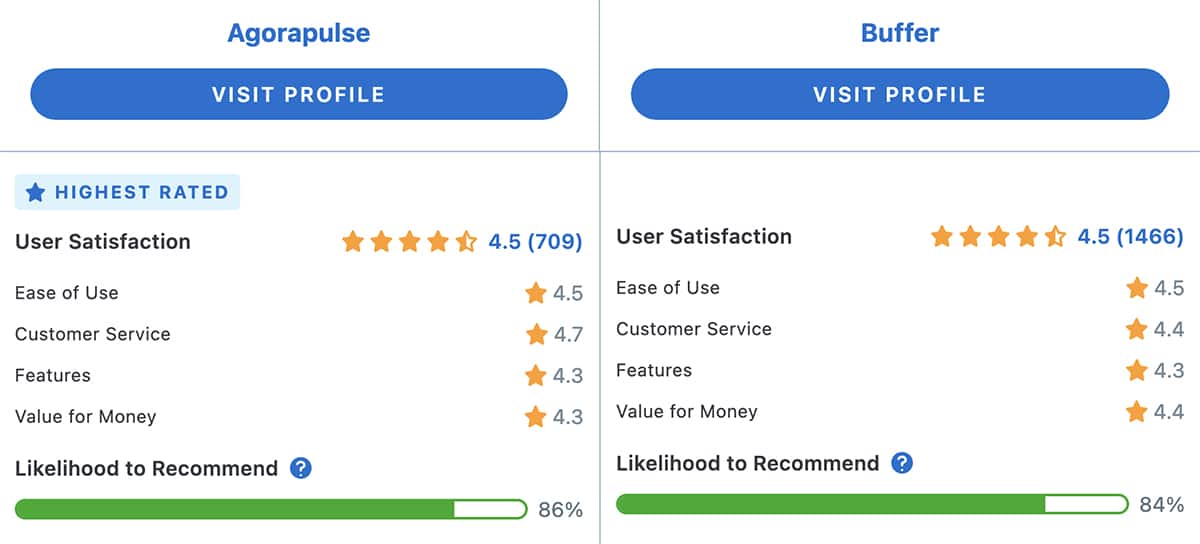
Capterra comparison of Agorapulse vs Buffer reviews
Quality of support
It’s true that social media managers find both social media management tools easy to set up and administer. But that doesn’t mean users won’t encounter problems or bugs. When they do, they’ll need reliable customer support.
However, here’s where things take a turn. Agorapulse far outranks Buffer for support. G2 reviewers give Agorapulse a 9.2 for quality of support, compared to Buffer’s 8.5.

G2 quality of support reviews of Agorapulse vs Buffer
For TrustRadius reviewers, the divide is even larger. On TrustRadius, Agorapulse gets an 8.7 compared to Buffer’s 6.4 rating.

TrustRadius support comparison of Agorapulse vs. Buffer
Why is the difference so significant? Compared to Agorapulse, Buffer provides much more limited customer support. If you have a Buffer account, your only options are sending an email or messaging the support team on social media (Facebook and X).
Yet Buffer doesn’t promise a specific response time. As a result, you could end up waiting a while for a response to your question. The vague message, “We are currently experiencing downtime …” that appears on Buffer’s support popup doesn’t inspire much confidence.
In contrast, Agorapulse offers email support for all plans and chat support for mid-tier paid plans and up. Enterprise users also get phone support to access help whenever they need it.
With Agorapulse, you never have to wonder when you’ll hear back from our support team. We commit to specific response windows for each plan tier. Enterprise users get a response in 30 minutes or less, while top-tier, mid-tier, and entry-level paid users get a response in 1 hour, 2 hours, and 6 hours or less, respectively.
Because Agorapulse offers 24/7 support, you don’t have to wait until the next business day for a response. As a result, you don’t have to worry about losing significant time or missing deadlines for marketing campaigns.
When you sign up for a demo, you’ll be able to experience first hand our stellar service and more.
3. Buffer Reviews: It lacks critical social media management features
To manage social accounts for your business or clients, you need a few essential features. While users give Buffer’s content features relatively high marks, the platform lacks features like a social inbox and social listening.
This Capterra chart compares the two platforms’ feature sets side by side. As you can see, Buffer has about half the features that Agorapulse has.
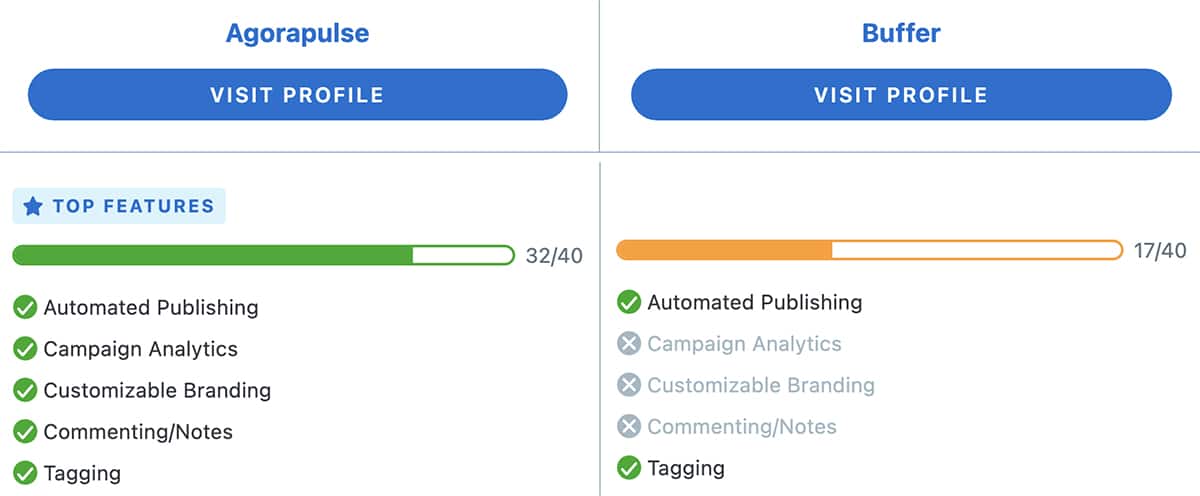
Capterra comparison of Agorapulse and Buffer reviews
It’s no surprise that overall, TrustRadius reviewers rate Buffer’s feature set much lower than Agorapulse’s. While 94% of Agorapulse reviewers are happy with the platform’s feature set, only 80% of Buffer reviewers report the same.

Buffer reviews of happy with the features set
Content calendar and social media scheduling
When you manage multiple social accounts for your business or clients, you need a platform that helps you reliably create and schedule posts. Agorapulse and Buffer have several content creation and scheduling tools in common, including:
- AI-powered writing assistant to optimize social media posts and help you save time
- Canva integration to publish graphics seamlessly without exporting or downloading
- Publishing tags to keep track of campaigns and content themes
- UTM parameters to track campaign results
G2 reviewers give the two platforms similar ratings for these features. Buffer’s content calendar (9.2) comes out slightly ahead of Agorapulse’s (9.1). But the platforms’ content libraries are tied (8.7).

G2 content comparison of Agorapulse vs. Buffer
However, TrustRadius reviewers clearly favor Agorapulse’s content planning and scheduling tools. Overall, Agorapulse has an 8.9 rating in this category, which is 12% above the category average. In contrast, Buffer has a 7.6, which is 4% below average.
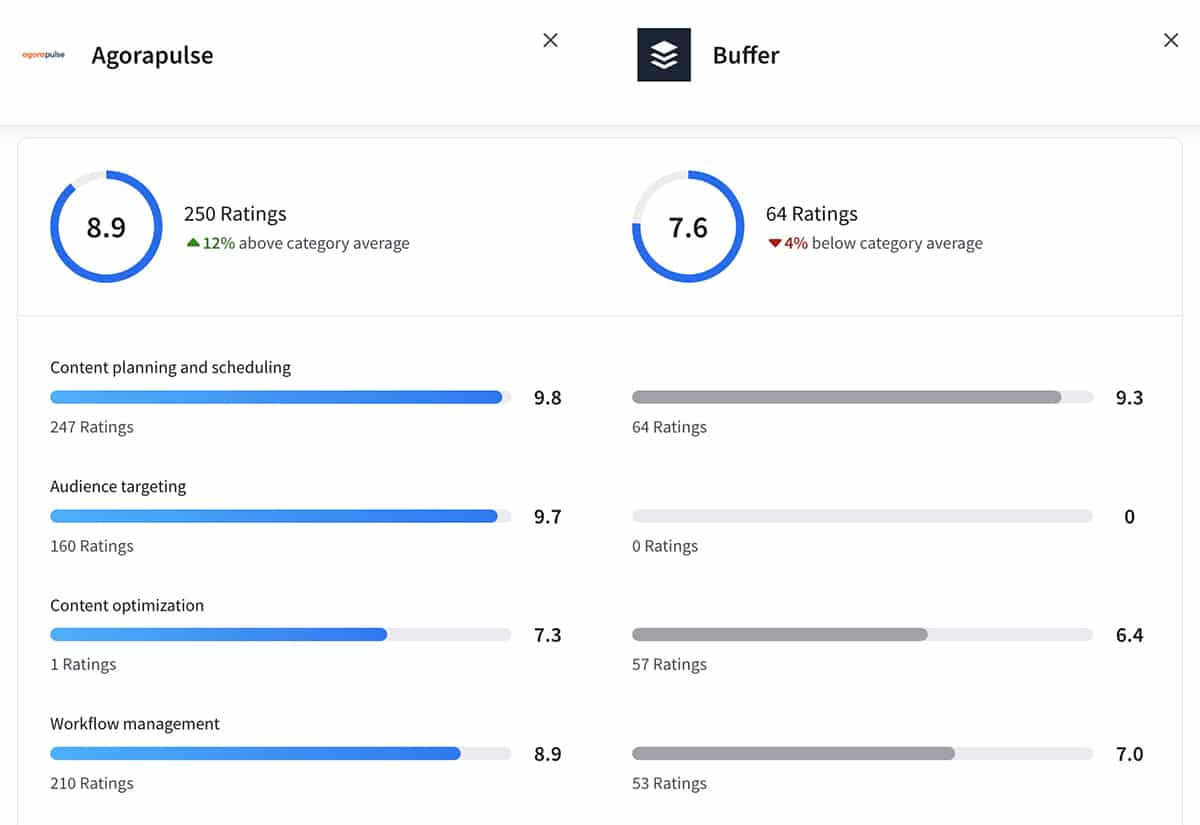
TrustRadius content comparison of Agorapulse vs. Buffer
Social media engagement
For most social media managers, publishing content is only the beginning. It’s just as important to engage with your audience by responding to comments and direct messages (DMs).
If you manage multiple social accounts across various channels, then you’ll likely want a single social media inbox. This way, you can respond to engagement quickly from a single dashboard and avoid having to jump from tab to tab.
You won’t find the solution you’re seeking in Buffer. After sunsetting its Reply engagement feature in 2020, Buffer hasn’t had a fully featured engagement solution. Instead, the platform only pulls comments from Facebook and Instagram.
If you want to respond to Facebook and Instagram DMs or any engagement at all on any other platform, you’re out of luck. Instead, you need another third-party tool—or you can spend time checking each social network throughout the day.
As a result, TrustRadius reviewers don’t rate Buffer’s engagement features at all. Agorapulse’s engagement features get an 8.5, which is 5% above the category average.
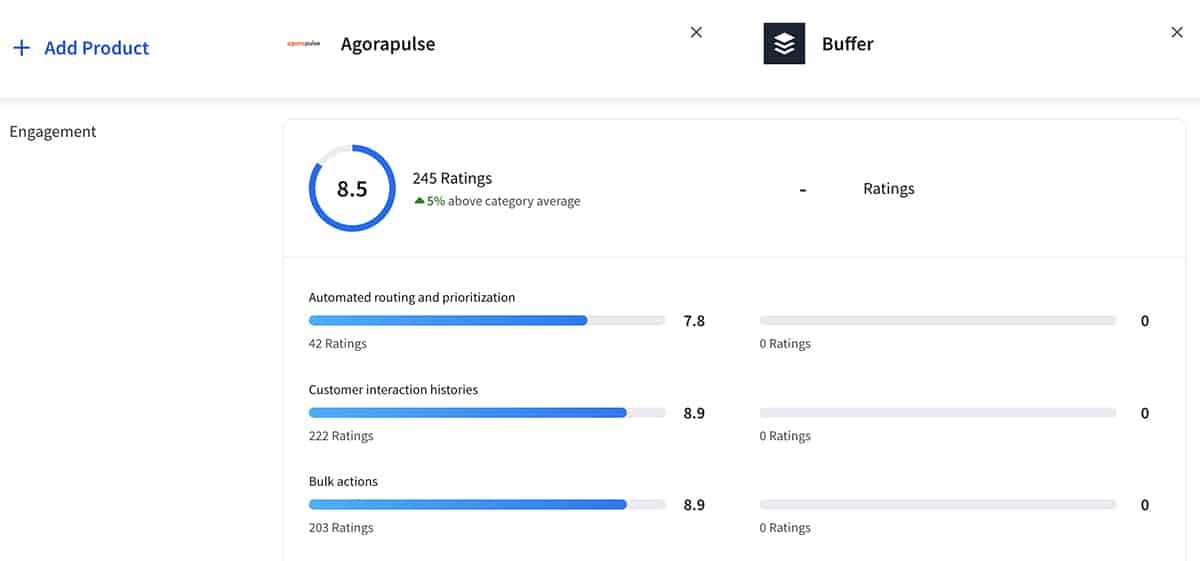
TrustRadius engagement comparison of Agorapulse vs. Buffer
Social listening
What are customers saying about your brand on social media outside of your comments and DMs? Social listening tools are essential for monitoring brand health, analyzing competitors, and learning about your audience.
While TrustRadius reviewers give Agorapulse an 8.9 for social listening, they don’t rate Buffer at all in this category. Once again, Buffer lacks a key feature for social media marketers.
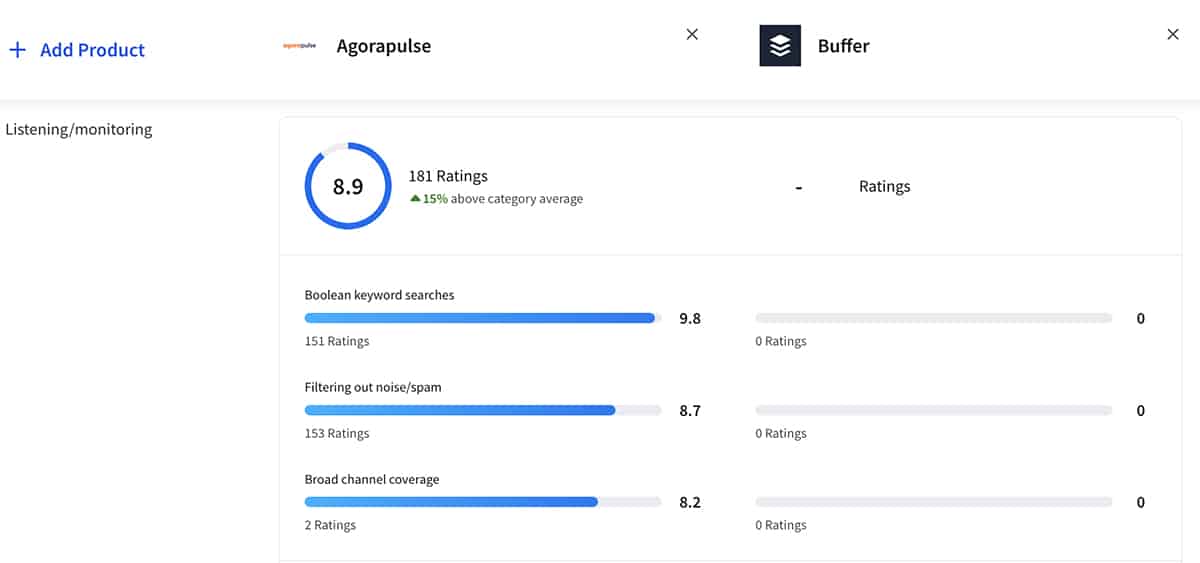
TrustRadius listening comparison of Agorapulse vs. Buffer review
With Agorapulse’s social listening feature, you can track brand keywords, campaign hashtags, or industry topics across social media channels. Since this feature includes sentiment analysis, you can quickly assess whether conversations are positive or negative.
Analytics and reporting
How quickly is your audience growing across social networks? Is your social media strategy working? To answer these questions, you need robust analytics and reporting.
Once again, Agorapulse outranks Buffer. G2 reviewers give Agorapulse an 8.8 for social analytics, which is nearly a full point higher than Buffer’s 7.9 rating.

G2 analytics comparison of Agorapulse vs. Buffer
The spread is even larger among TrustRadius reviewers. Agorapulse earns a 9.5 for reporting and analytics, while Buffer gets a 7.8.
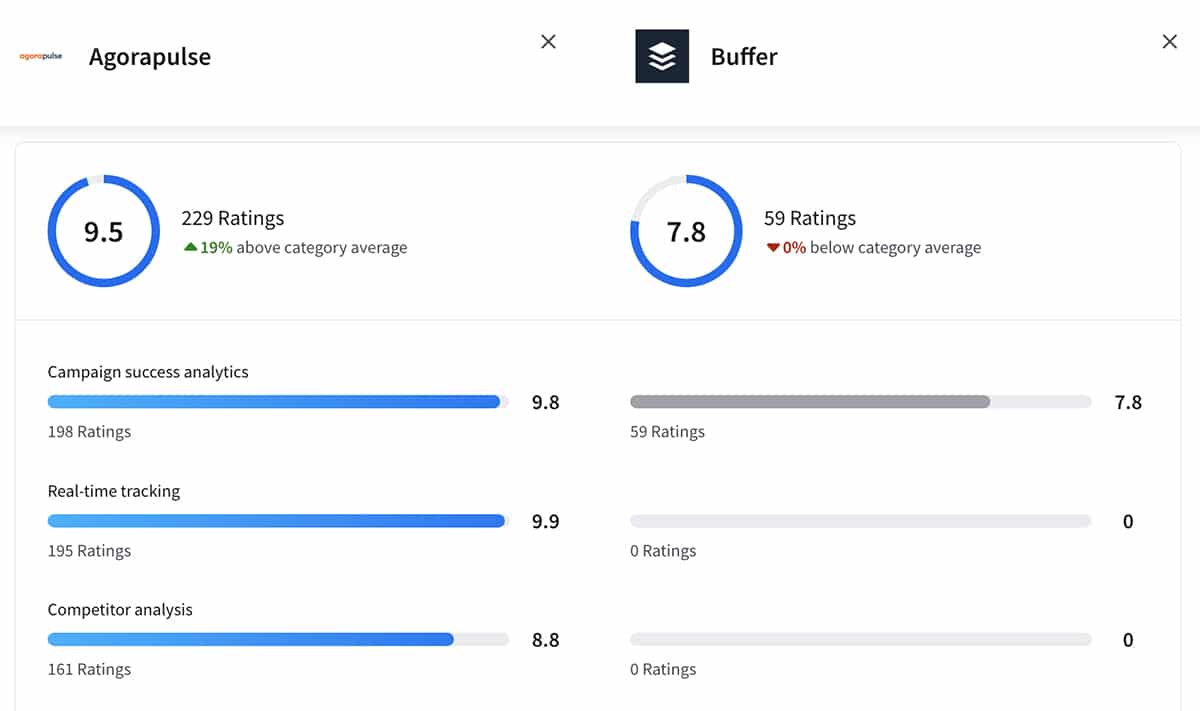
TrustRadius analytics comparison of Agorapulse vs. Buffer
Why do reviewers prefer Agorapulse over Buffer for reporting and analytics? Agorapulse offers more than just standard social media reporting, which typically includes audience, content, and community management analytics.
Agorapulse also offers return on investment (ROI) reports that track what happens after someone clicks on links in your social media posts, comments, or DMs. These social media ROI reports reveal the total number of clicks, leads, and conversions—including revenue. As a result, they’re ideal for proving the value of your social media strategy.
4. Buffer Reviews: Buffer is cheaper but offers less value for money
Any social media management platform you choose should fit your budget and offer plenty of value for money. So, which platform is the best investment for your team?
Buffer pricing uses a social media channel-based model. Essentially, you pay as little as $6 per channel per month. If you’re a social media team of one and you don’t need to manage many social accounts, Buffer may seem affordable.
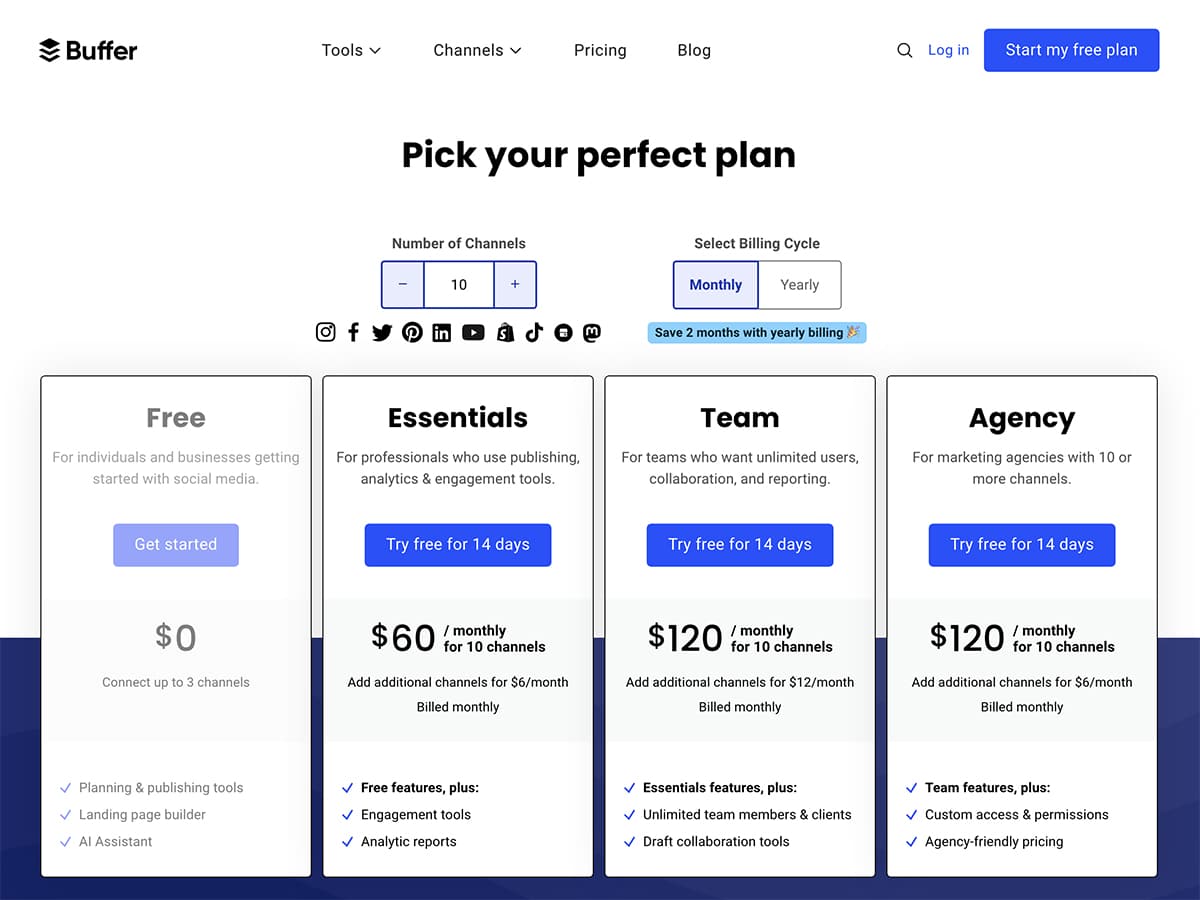
Buffer pricing plans
But there’s a catch. The Essentials team is designed for individual users. If you need to onboard a team, you’ll need to upgrade to the Team plan. While this plan supports unlimited users, each social channel costs $12 per month.
Again, this pricing may look affordable at a glance. But keep in mind that Buffer is missing several essential social media marketing features. As a result, you’ll likely have to purchase one or more extra tools to pick up the slack.
In contrast, Agorapulse pricing has a user-based model. Pricing for the entry-level (Standard), mid-tier (Professional), and top-tier (Advanced) plans include 10 social profiles and one user.
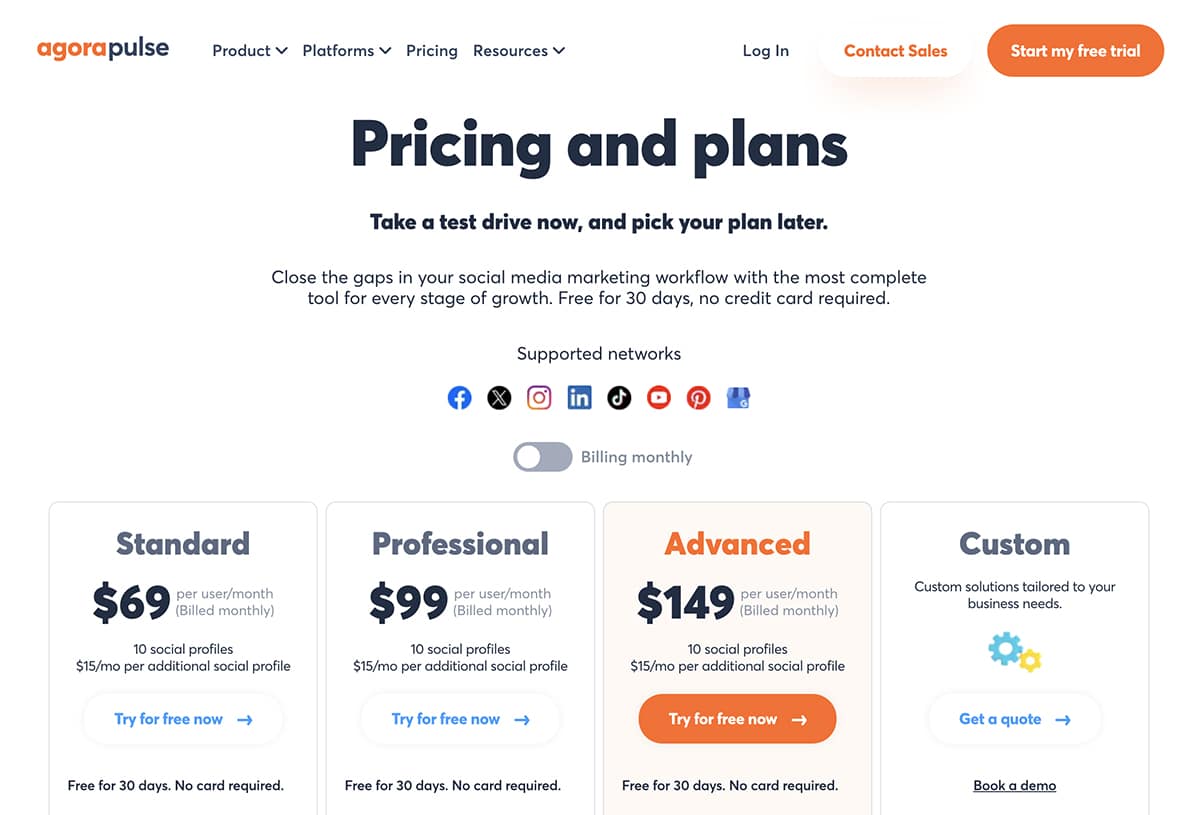
Agorapulse pricing plans
You certainly aren’t limited to 10 social accounts and a single user. Instead, you can add extra social profiles for $15 each per month. To add extra users, you’ll need to purchase a separate seat. In other words, multiply the base price by the number of team members you need to onboard.
For larger teams, Agorapulse may seem pricier. But because it has a much longer feature list, it can help you avoid having to purchase multiple disconnected tools. As a result, you can manage your entire social media strategy with Agorapulse—from content creation and scheduling to engagement and listening to analytics and reporting.
5. Buffer Reviews: Buffer isn’t as good as Agorapulse for agencies
When you manage social media for agency clients, you typically need a platform with added capacity. For example, you’ll likely need to add more social profiles, provide clients with access, and create custom reports.
Agorapulse’s Custom plan has everything marketing and social media agencies need to thrive. This plan includes unlimited social profiles along with agency-specific features like:
- Unlimited shared calendars that let clients review and approve content for their accounts.
- Approval workflows that support internal or external stakeholders (or both).
- HubSpot and Salesforce integrations that link contacts to Agorapulse’s social inbox.
- Custom white label reports that let you share the metrics that matter with each client.
- Advanced social media ROI reports that make it easy to prove the value of your work.
- Team performance reports so you can keep everyone on track.
- Priority phone, email, and chat support so you can access help when you need it.
- Single sign-on (SSO) for added security.
- Facebook boosted post scheduling so you can help clients reach marketing goals faster.
Technically, Buffer has an Agency plan. But it appears to be an agency plan in name alone.
In other words, it doesn’t include any agency-specific features. The only difference from the Team plan is that the Agency plan offers custom access and permissions and a lower cost per profile when you add more than 10 social profiles.
It’s not surprising that Buffer lacks a custom agency plan with unique features. In his letter, Buffer’s CEO and co-founder explains that the platform intends to focus on a core customer base of small businesses and entrepreneurs. In other words, Buffer doesn’t intend to provide a viable solution for agencies.
Wrapping Up Our Buffer Reviews Analysis
It’s easy to see why G2, Capterra, and TrustRadius reviewers rank Agorapulse ahead of Buffer in most categories. Our robust feature set and customizable plans are just the beginning.
Users also see Agorapulse as a good business partner and a product that continues to release new features and develop in the right direction. As a result, Agorapulse is a smart choice for small businesses and large agencies—and almost any type of team in between.

